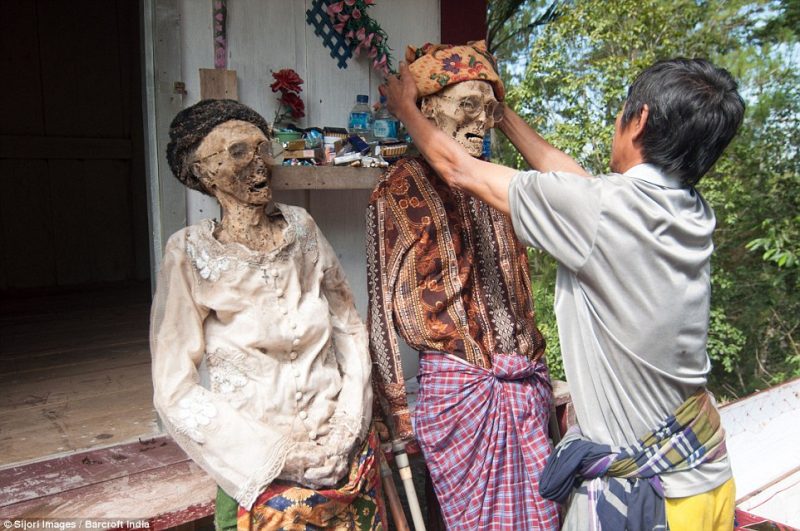Benjamin Franklin once said, “…in this world nothing can be said to be certain, except death and taxes.’’ While one occurs habitually, from an artisan coffee purchase to your paycheck; the same can’t be said about the other, which happens just once. When experiencing the death of a loved one, most people feel the funeral would be the final place to bid adieu to the departed.
Not so in Tana Toraja Regency in South Sulawesi, that starfish-shaped island east of Borneo. The Toraja are an ethnic indigenous group that inhabits the mountainous region and the term is derived from the Bugis language that means, “people of the mountains.” Their traditions and heritage can be traced back to more than 700 years and were pretty much unknown to the outside world until the 1970’s after Dutch missionaries reported their elaborate funeral rites.
To Torajans, the death of a loved one is not final and death itself is viewed as the single most important event of the life cycle. When a Torajan dies, the deceased is embalmed and placed at home. They are not considered “dead” until a funeral takes place, which could be months or years later. In the interim, they are deemed as “sick” and household members tend to them round the clock with food and beverages. They are treated as a guest and it is not uncommon to have more than one sitting around in the home.
A Torajan funeral, also known as rambu solo, has often been coined as one of the most complex funeral ceremonies in the world. Depending on social status, funerals of a middle-class family may last three days whereas wealthier families may conduct an 11-day funeral.
Most funerals are held during the dry season from June to November. The delay for funerals would allow Torajans to make their way back to attend but is usually for poorer families to raise money. The bulk of the funds raised is used to purchase buffaloes and pigs, which would feed attendees throughout the days. Some families borrow heavily from neighbours with debts being passed on to the next generation.
During the funeral, the body of the deceased is placed in a high-roofed tower at the end of a field. Attendees often bring gifts for family members and are ushered onto bamboo platforms to witness buffalo fights, which marks the beginning of the funeral. This is followed by singing, dancing and chanting; all leading up to the slaughtering of the horned beasts and pigs.
The meat is distributed to the attendees and the skulls of the slaughtered buffalos are displayed outside the house of the deceased. After the ceremony, the burial sees the body being hoisted up to a stone grave in a cliff. Wealthier families often hire craftsmen to carve tau-tau; wooden statues bearing the departed’s physical features, which are placed on the cliff-side graves.
Bodies are then exhumed to be cleaned and dressed in new clothes every three years. Damaged caskets are fixed or replaced as well. This ritual usually takes place in the month of August and is known as ma’nene, which translates to, “the ceremony of cleaning corpses.” It is a mark of respect to strengthening the bond between life and death. Frequently, the ma’nene ritual is conducted at Lembang Paton Village. The dead are brought back to their village houses, and family members are the only ones allowed to dress them. Finally, the corpses are paraded around the village to “meet with” their living relatives, friends and tourists.
According to UNESCO, the importance of preserving the Torajan traditions lies in the fact that such complicated and expensive ceremonies sustain many aspects of prehistoric megalithic culture which cannot be found in any other part of the world today.
A recent visit to Tana Toraja by Indonesian Vice President Jusuf Kalla (who also hails from South Sulawesi) played a significant role in the area’s designation as the eleventh emerging tourist destination in Indonesia. It was reported that a special team comprising of members from various ministries and agencies have been set up to spur the development of Tana Toraja. The government hopes to double arrivals to the regency by upgrading the existing Pongtiku Airport and is also budgeting for the construction of the new Buntu Kuni Airport.
Tourism to Tana Toraja has grown steadily over the years. The income generated from tourism has made significant changes to the highland; souvenir shops and restaurants of various cuisines available to cater to the influx of tourists.
If you fancy a trip to Tana Toraja, the closest major airport is in Makassar. From Makassar, tourists usually commute by car to Rantepao. The trip from Makassar to Toraja by land can take up to 10 hours. Tana Toraja’s aromatic coffee is also well known by connoisseurs. Brewed from the finest coffee beans, its distinct caramel flavour can certainly help take the edge off a long car journey.
See: Tana Toraja: Love for the Departed
Featured image by Daily Mail.




